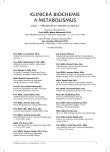Online solid phase extraction analytical system coupled to tandem mass spectrometry for clinical applications.
Authors:
I. Vrobel 1,2; D. Friedecký 1,2; T. Adam 1,2
Authors‘ workplace:
Ústav molekulární a translační medicíny, Univerzita Palackého v Olomouci
1; Oddělení klinické biochemie, Fakultní nemocnice a Univerzita Palackého v Olomouci
2
Published in:
Klin. Biochem. Metab., 26, 2018, No. 1, p. 11-17
Overview
Objective:
Introduction to the online solid-phase extraction system coupled to tandem mass spectrometry (SPE-MS/MS). Assessment of the suitability of this system for clinical laboratories as an alternative to liquid chromatography coupled to tandem mass spectrometry (LC-MS/MS).
Methods:
Characterization of functional principle of the online SPE-MS/MS system. Description of crucial parameters that has to be followed and evaluated during method development. Brief summary of so-far published methods based on utilization of this technique from the fields of toxicology, therapeutic drug monitoring and clinical biochemistry.
Results and discussion:
The online SPE-MS/MS system enables fast determination of analytes in common biological matrices. The system ensures extensive cleaning of the sample. High sensitivity is provided by utilization of multiple reaction monitoring (MRM) mode in tandem mass spectrometer. The analysis of one sample takes usually around 15 sec. This leads to significant speeding of the analytical process in comparison to methods based on LC-MS/MS. At the same time all requirements for validation of bioanalytical methods are met. The key parameters assessed during method development process are the matrix effect, carry-over, potential isobaric interferences and fragmentation of labile conjugates in the ion source.
Conclusion:
The online SPE-MS/MS system can be used advantageously in the range of clinical applications, particularly in the case of exogenous analytes occurring in the sample at relatively high concentrations. Nevertheless, this system cannot be exploited for all types of analytes. In many cases, it can, however, significantly speed up and cheapen the analytical process and suitably complement the LC-MS/MS systems.
Keywords:
SPE-MS/MS, RapidFire, mass spectrometry, solid phase extraction, quantitative analysis.
Sources
1. Jannetto, P. J., Fitzgerald, R. L. Effective use of mass spectrometry in the clinical laboratory. Clin. Chem. 2016, 62, 92-8.
2. Food and Drug Administration, Guidance for Industry: Bioanalytical Method Validation, 2001, http://www.fda.gov/downloads/Drugs/GuidanceComplianceRegulatoryInformation/Guidances/ucm070107.pdf (25.08.2017)
3. European Medicines Agency, Guideline on bioanalytical method validation, 2011, http://www.ema.europa.eu/docs/en_GB/document_library/Scientific_guideline/2011/08/WC500109686.pdf (25.08.2017)
4. Friedecký, B., Šprongl, L., Kratochvíla, J., Plzák, Z. Doporučení k provádění validace a verifikace analy-tických metod v klinických laboratořích. Klin. Biochem. Metab. 2011, 19 (40), No. 1, p. 36-44.
5. Niessen, W. M. A. Liquid Chromatography - Mass Spectrometry, 3rd edition, CRC Press, 2007, p. 15-16. ISBN-13: 978-0-8247-4082-5.
6. Wang, S., Cyronak, M., Yang, E. Does a stable isotopically labeled internal standard always correct analyte response? A matrix effect study on a LC/MS/MS method for the determination of carvedilol enantiomers in human plasma. J. Pharm. Biomed. Anal. 2007, 43, 701-707.
7. Klapková, E., Uřinovská, R., Průša, R. Vliv matricových efektů při vývoji a validaci metod pomocí vysokoúčinné kapalinové chromatografie ve spojení s hmotnostní spekt-rometrií. Klin. Biochem. Metab. 2011, 19 (40), No. 1, p. 5-8.
8. Matuszewski, B. K., Constanzer, M. L., Chavez-Eng, C. M. Strategies for the Assessment of Matrix Effect in Quantitative Bioanalytical Methods Based on HPLC-MS/MS. Anal. Chem. 2003, 75, 3019-3030.
9. Jian, W., Romm, M. V., Edom, R. W., et al. Evaluation of a High-Throughput Online Solid Phase Extraction – Tandem Mass Spectrometry System for In Vivo Bioanalytical Studies. Anal. Chem. 2011, 83, 8259-8266.
10. Yan, Z., Caldwell, G. W., Jones, W. J., Masucci, J. A. Cone voltage induced in-source dissociation of glu-curonides in electrospray and implications in biological analyses. Rapid Commun. Mass Spectrom. 2003, 17, 1433-1442.
11. Danso, D., Jannetto, P. J., Enger, R., Langman, L. J. High-throughput validated method for the quantification of busulfan in plasma using ultrafast SPE-MS/MS. Ther. Drug Monit. 2015, 37, 319-24.
12. Slattery, J. T., Risler, L. J. Therapeutic monitoring of busulfan in hematopoietic stem cell transplantation. Ther. Drug Monit. 1998, 20, 543-9.
13. Grote-Koska, D., Czajkowski, S., Brand, K. Performance of the new RapidFire system for therapeutic monitoring of immunosuppressants. Ther. Drug Monit. 2015, 37, 400-4.
14. Korman, E., Langman, L. J., Jannetto, P. J. High-throughput method for the quantification of lacosamide in serum using ultrafast SPE-MS/MS. Ther. Drug Monit. 2015, 37, 126-31.
15. Widmer, N., Bardin, C., Chatelut, E., et al. Review of therapeutic drug monitoring of anticancer drugs part two – Targeted therapies. Eur. J. Cancer. 2014, 50, 2020-36.
16. Vrobel, I., Janečková, H., Faber, E., et al. Ultrafast online SPE-MS/MS method for quantification of 3 tyrosine kinase inhibitors in human plasma. Ther. Drug Monit. 2016, 38, 516-24.
17. Veach, B. T., Mudalige, T. K., Rye, P. RapidFire mass spectrometry with enhanced throughput as an alternative to liquid-liquid salt assisted extraction and LC/MS analysis for sulphonamides in honey. Anal. Chem. 2017, 89, 3256-60.
Labels
Clinical biochemistry Nuclear medicine Nutritive therapistArticle was published in
Clinical Biochemistry and Metabolism

2018 Issue 1
Most read in this issue
- Determination of Carbohydrate Deficient Transferrin (CDT) by various analytical techniques
- Vitamin K and its importance in laboratory medicine
- Online solid phase extraction analytical system coupled to tandem mass spectrometry for clinical applications.
- Initial study of FGF 23 measurement by LIAISON FGF 23 method
